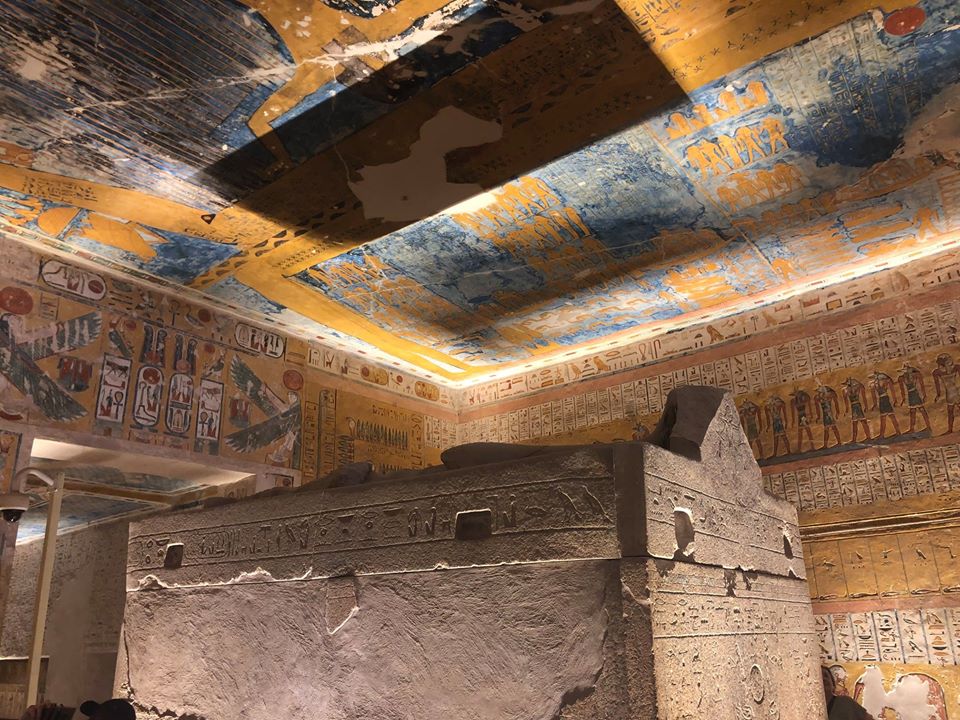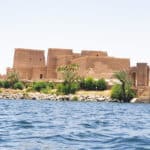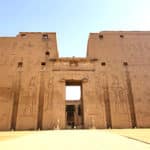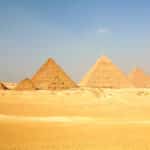The land of ancient Egypt was animated by the spirit of the gods. Every morning, the sun god Ra came out of the darkness in his great boat, bringing light. As well as many gods watched over the people during the night like the stars. Osiris caused the Nile to flood its banks and fertilize the land while Khnum directed its flow.
Isis and her sister Nephthys and the other gods ofEgypt accompanied the inhabitants of the earth in life and protected them after death. Also like many other gods did. And Bastet guarded the lives of women and watched over the house. Tenenet the goddess of beer and brewing and also featured during childbirth. While Hathor, who had many roles, among the lady of drunkenness, everyone's close companion at parties or festivals.
Egypt's gods and goddesses did not present themselves as distant deities to be feared. But close friends who lived among the people in the temples built for them. Also in trees, lakes, streams, swamps, and in the desert beyond the Nile valley. When hot winds blew arid waste. It was not just a confluence of air, but the god Set that was causing trouble. When rain fell, it is a gift from Goddess Tefnut. “She from the humidity”. Also associated with drought and asked to hold back the rain on feast days.
Human beings are born from the tears of Atum (also known as Ra). When he wept with joy at the return of his children Shu and Tefnut to the beginning of time when the world was created from the waters of chaos. In all aspects of life, the deities of Egypt are present and continued to care for their people after death.
The origins of Egyptian gods and deities
Belief in supernatural entities is attested as early as the predynastic period in Egypt (circa 6000-3150 BC). But the practice is probably much older.
The Egyptians lived with forces they did not understand. Storms, earthquakes, floods and dry spells all seemed inexplicable. But people realized that natural forces had an impact on human affairs. Nature spirits are therefore considered powerful in view of the damage they could inflict on humans.
Early beliefs in the gods of Egypt took the following forms. First of all, animism. The belief that inanimate objects, plants, animals. Also the earth have a soul and are imbued with the divine spark. Also fetishism, the belief that an object has consciousness and supernatural powers.
Then totemism, the belief that individuals or clans have a spiritual relationship with a certain plant. A certain animal or symbol. In predynastic times, animism was the main understanding of the universe. As is the case with the first inhabitants of any culture.
Life after death
The Egyptians firmly believed that death is just a doorway to another form of existence. They therefore recognized the possibility that the dead were more powerful in their resurrection state. Thus, the politically, spiritually, or magically powerful members of each community took on special significance in death or in the realm beyond the grave.
Particular care was taken to render honors, offerings and respect to these souls. It was believed that the dead could get involved in the affairs of the living, for good or ill. So may they be appeased by daily sacrifices.
Belief in an afterlife gave rise to understanding. Only supernatural beings who presided over this other kingdom which connected them to the earth plane in a transparent way. Furthermore, the experience of death requires an explanation and a meaning. Which are provided by the belief in higher powers.
Animism branched out into fetishism and totemism. Fetishism is illustrated by the symbol of the djed, which represents earthly and cosmic stability. Moreover, it is believed that the symbol of the djed is originally a sign of fertility. Then associated with Osiris as inscriptions such as “the djed is lying on its side. meant that Osiris is dead. While the resurrection of the djed symbolized his resurrection.
Totemism developed from local association with a certain plant or animal. While each nome (province) in ancient Egypt had its own totem. Although it is a plant, an animal or a symbol. So that signified the spiritual connection of the people with this place.
Each Egyptian army marched into battle, divided into nomes. Although each nome carried his own stick that made his totem fly. The individuals each had their own totem, their own spiritual guide who particularly watched over them. The king of Egypt, at any time is watched over by a falcon which represented the god Horus.
Over time, these spirits understood by animism became anthropomorphic. (Ascribing human characteristics to non-human things). Then the invisible spirits that inhabited the universe were given form. A face and names and became the deities of ancient Egypt.
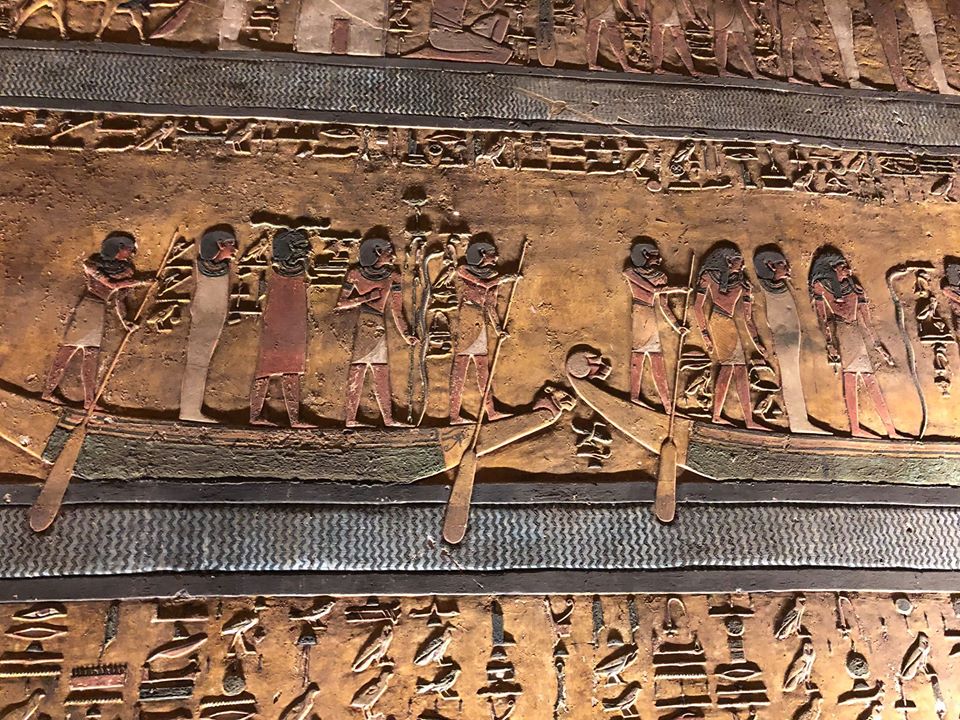
Mythological origins
The myth of the primary creation of the Egyptians begins with the stillness of the primordial waters. So before the beginning of time. From these endless and depthless waters rose the primordial mound (the ben-ben). The pyramids of Egypt are interpreted as representing this first hill of earth. To rise from primordial depths. Eternal existing with these silent waters (Nu) was heka – magic – personified in the god Heka. While in some versions of the myth, raises the ben-ben.
On the mound stood the god Atum (or Ra) or, in some versions. So He lands on him from the air. Atum looked into nothingness and recognized his loneliness and so, through Hekka. He mated with his own shadow to give birth to two children. Shou (god of the air, whom Atum spat) and Tefnut (goddess of humidity, whom Atum vomited). Shu gave the primitive world the principles of life, while Tefnut brought the principles of order.
Leaving their father on the ben-ben, they set out to establish the world. Over time, Atum grew concerned that his children were gone for so long. So he removed his eye and sent it to find them. While his eye was gone. Atum sat alone on the hill amid the chaos and gazed into eternity. Shu and Tefnut returned with the Eye of Atum (represented as the famous all-seeing eye). And their father, grateful for their safe return, shed tears of joy.
These tears, which fell on the dark and fertile land of ben-ben. Gave birth to men and women. These creatures having nowhere to live. So Shu and Tefnut mated to give birth to Geb (earth) and Nut (sky). They fell so deeply in love and inseparable.
Atum displeased and pushed them away from each other. By raising Nut above Geb and attaching it to the vault of the cosmos. But she is already pregnant with Geb. Then she gave birth to the first five gods: Osiris, Isis, Seth, Nephthys and Horus. From these original gods then came all the others.
Another version of creation is very similar but includes the goddess Neith. One of the oldest of all Egyptian deities. In this version, Neith is the wife of Nu, the primordial chaos, who gives birth to Atum and all the other gods.
However, even in this myth, Heka predates Neith and the other gods. In a number of inscriptions throughout Egyptian history, Neith is referred to as the "Mother of the Gods" or the "Mother of All". Moreover, she is among the oldest examples of the figure of the mother goddess in history. In yet another version, the Nu (chaos) is personified as Nun. The father and mother of all creation who give birth to the gods and all that exists in the universe.
The qualities of the primitive state, like its darkness, are endowed with consciousness. They also became a group of deities known as the Eight or the Ogdoad of Hermopolis. Eights were imagined as amphibians and reptiles. Also fertile creatures of the primitive dark mud. Forces that shaped the creator or even the first manifestations of the creator.
The symbol of ouroboros, the serpent swallowing its own tail, representing eternity. In fact it comes from this connection of the serpent with creation and the divine. Moreover Atum (Ra) is represented in the first inscriptions as a serpent. Then later he is the serpent-god-sun (or a sun deity protected by a serpent). Who fights the forces of chaos symbolized by the serpent Apophis.
The nature of the gods and goddesses
The gods of ancient Egypt maintained harmony and balance after the First split at creation. In the beginning with the appearance of the ben-ben and the birth of the gods, multiplicity entered into creation. So the One has become the multiple.
Egyptian religious beliefs centered on the balance of this "multiple". By the principle of harmony known as ma'at. In fact, ma'at is the central value of Egyptian culture. Although influencing all aspects of people's lives. From how they conducted themselves to their art, their architecture, their literature, and even their vision of the afterlife. The power that allowed the gods to perform their tasks. Which allowed human beings access to their gods and which supported the ma'at which is the heka. Heka, the god, is depicted in the coffin texts as existing before any other deity.
Just like the people of Mesopotamia. From which some scholars claim that the Egyptians developed their beliefs in the gods of Egypt. The people of Egypt believed they were partners with the gods in maintaining order. Also keep the forces of chaos at bay. The story that best illustrates this concept is the Overthrow of Apophis which generated its own ritual.
Apophis the primordial serpent who, each night, attacked the solar boat of Ra. As she walked through the darkness towards dawn. The gods of Egypt are on board the boat with Ra to protect him from Apophis. So the souls of the dead also had to help repel the serpent. One of the most famous images in this story shows the god Seth. Before he was known as the villain of the Osiris mythos, piercing the serpent and shielding the light.
The ritual that grew out of the story included making images of Apophis from wood or wax. Then their destruction by fire to help the souls of the dead and the deities. Who traveled with them to bring the morning sun. Cloudy days are inconvenient for the ancient Egyptians as they were considered a sign that Apophis ruled over Ra. Also a solar eclipse is a source of great fear. The people through rituals and devotion to the gods of Egypt. Helped the sun rise every morning and every day is seen as a struggle between law and order and chaos.
When talking about the creator gods of Egypt like Atum as serpents. They generally represent the positive aspect of chaos as an energetic force. But they had a negative counterpart in the great serpent Apophis. Apophis represented the destructive aspect of chaos that was constantly trying to overwhelm all individual beings and return everything to its pristine state of "oneness". Thus, even before creation began, the world contained the elements of its own destruction.
The principle of divine death applies, in fact, to all the gods of Egypt. Texts dating at least from the New Kingdom tell that the god Thoth assigns fixed lifespans to humans as well as to gods. As chapter 154 of the Book of the Dead states unequivocally that death (literally, “decline” and “disappearance”) awaits “every god and goddess”.
It was believed that the heart is the center of a person's personality and spirit. Non-existence is terrifying to Egyptians. The Egyptians feared eternal darkness and unconsciousness in the afterlife. The elaborate vision of the Egyptian afterlife as a perfect reflection of life on earth developed precisely because of this fear of non-existence. As well as the loss of self. When the gods of Egypt would finally die, after millions of years. So human beings would die with them and all human history would lose its meaning.
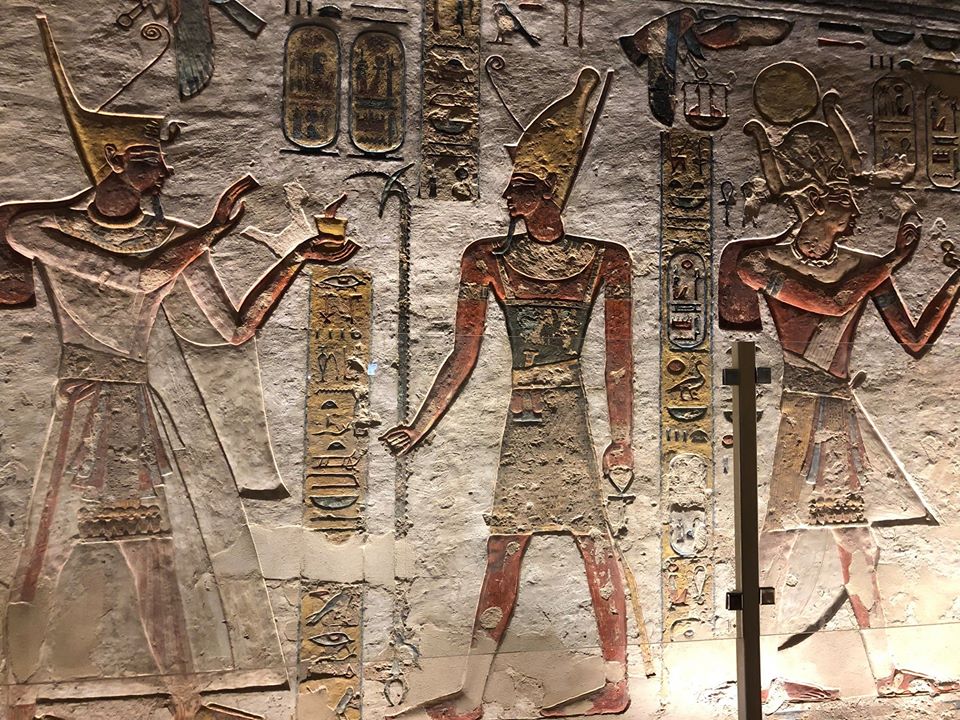
The death of the gods and goddesses of Egypt
The gods and goddesses of ancient Egypt eventually died out and it didn't even take millions of years. The rise of Christianity meant the end of religious practices in ancient Egypt. Also the advent of a world imbued and supported by magic. God now resided in heaven, a single deity far from earth. And there is no longer the multiplicity of gods and spirits that inhabited daily life.
Even if this new god could be present through his son Jesus Christ. He is always described by the Christian scriptures as “dwelling in unapproachable light” (I Timothy 6:16). The image of the divine serpent is taken by the Jewish scribes. And transformed into a symbol of the fall of human beings from paradise (Genesis 3). As well as the land itself, far from imbued with the spirits of friendly gods.
By the 5th century CE, the Egyptian gods fell into decline, and by the 7th century they had disappeared.
In AD 383, pagan temples throughout the Roman Empire were closed by order of Emperor Theodosius. And other decrees, sanctioned the effective destruction of pagan religious structures. Soon most Egyptian temples were avoided, claimed for other uses, or actively destroyed by zealous Christians. Finally, the old gods are largely deserted.
Beliefs in the gods of Egypt have survived despite attempts by Christianity to destroy them. Then Islam. The myth of Osiris, with its dying and rising figure of God, became central to the cult of Isis. Who traveled to Greece after the conquest of Egypt by Alexander the Great in 331 BC.
From Greece, the cult of Isis was transported to Rome. Where his worship became the most popular religious belief in the Roman Empire before the rise of Christianity. Temples of Isis were found throughout the ancient world. From Pompeii to Great Britain, passing through Asia Minor and all of Europe.
The concept of God dying and rising again, established by the myth of Osiris, is now manifested in the figure of the son of God. Jesus the Christ. Over time, the epithets of Isis became those of the Virgin Mary. Such as "Mother of God" and "Queen of Heaven". For the new religion relied on the power of the old creed to establish itself. The Abydos triad, made up of Osiris, Isis and Horus. Has become the Trinity of Father, Son and Holy Spirit in the new religion. Who had to destroy the old belief to achieve supremacy.
The Temple of Isis on Philae in Egypt is believed to be the last surviving pagan temple. Records show that in 452 CE, pilgrims visited the Philae temple and removed the statue of Isis. Wearing it in honor as before to visit the neighboring gods of Nubia.
However, at the time of Emperor Justinian in 529 CE, all pagan beliefs were suppressed. No doubt there were pockets of resistance to the new faith.
In 639 AD, when Arab armies claimed Egypt. They found only Christians and the lost legacy of the old gods. Who had ruled one of the greatest centers of civilization for well over 3,000 years.
The gods and goddesses of Egypt will never completely disappear, however. They infused the new monotheistic ideologies of Judaism, Christianity and Islam.
Among the five pillars of Islam, prayer, pilgrimage, fasting and almsgiving were practiced a millennium earlier by the ancient Egyptians in the worship of their gods.
The concept of heka, an eternal, invisible force that empowers creation and sustains life. Developed by the Greeks and Romans and Neo-Platonists as Logos. And We, respectively, and these two philosophies influenced the development of Christianity.
Today, people commonly refer to the faith of the ancient Egyptians as a primitive, polytheistic faith. However, the gods of Egypt worshiped for over 3,000 years.
And the only religiously themed conflict recorded during the reign of Akhenaten (1353-1336 BC), when the king insisted on a monotheistic reverence for the supreme god Aten. And even that is most likely a political maneuver to diminish the power of the priests of Amun.

